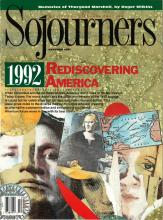In school I was taught the names
Columbus, Cortez, and Pizzarro and
A dozen other filthy murderers.
A bloodline all the way to General Miles,
Daniel Boone, and General Eisenhower.
No one mentioned the names
Of even a few of the victims.
But don't you remember Chaske, whose spine
Was crushed so quickly by Mr. Pizzaro's boot?
What words did he cry into the dust?
What was the familiar name
Of that young girl who danced so gracefully
That everyone in the village sang with her
Before Cortez' sword hacked off her arms
As she protested the burning of her sweetheart?
That young man's name was Many Deeds,
And he had been a leader of a band of fighters
Called the Redstick Hummingbirds, who slowed
The march of Cortez' army with only a few
Spears and stones which now lay still
In the mountains and remember.
Greenrock Woman was the name
Of that old lady who walked right up
And spat in Columbus' face. We
must remember that, and remember
Laughing Otter the Taino who tried to stop
Columbus and who was taken away as a slave.
We never saw him again.
In school I learned of heroic discoveries
Made by liars and crooks. The courage
Of millions of sweet and true people
Was not commemorated.
Let us then declare a holiday
For ourselves, and make a parade that begins
With Columbus' victims and continues
Even to our grandchildren who will be named
in their honor.
Because isn't it true that even the summer
Grass here in this land whispers those names,
And every creek has accepted the responsibility
Of singing those names? And nothing can stop
The wind from howling those names around
The corners of the school.
Why else would the birds sing
So much sweeter here than in other lands?
Read the Full Article
